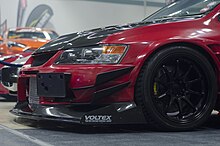Body kit


A body kit or bodykit is a collection of exterior modifications to a car, typically composed of front and rear bumpers, side skirts, spoilers, paint jobs, and sometimes front and rear side guards and roof scoops. There are many companies that offer alternatives to the original factory appearance of the vehicle. Body kits components are designed to complement each other and work together as a complete design. Despite this, the 'mix and match' approach is often seen on cars, where the front of one body kit will be matched with the rear of another, for example.
Automotive body kits are usually constructed of either fiberglass, polyurethane, or in some cases carbon fiber. Fiberglass is cheap and widely available, although it can crack upon impact. Polyurethane is popular because it is flexible and thus more resistant to damage. Carbon fiber body kits are rare, due to the cost of the materials, and are rarely seen on street-legal vehicles.
Factory-fitted body kits are now becoming more common, perhaps in response to the growth of the aftermarket tuning industry in the late 1990s and onwards. Many manufacturers now work in-house with their motor sport divisions to develop styling upgrades.
Popular culture
In video games like Need for Speed: Underground (2003) and beyond, Tokyo Xtreme Racer 3 (2003), Grand Theft Auto: San Andreas (2004), Ridge Racer 7 (2006), Juiced series (2005), The Fast And The Furious: Tokyo Drift (2007), MotorStorm: Arctic Edge (2009), etc., the vehicles can be modified in many ways, including with body kits.
See also
- Downforce
- Kit car
- Pimp My Ride, a television series about vehicle restoration and modification that uses body kits extensively
